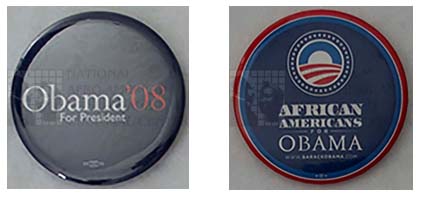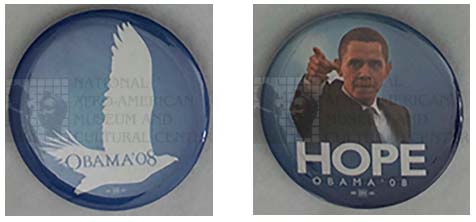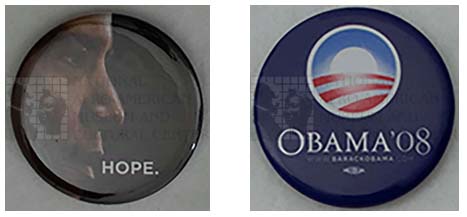Pin-back buttons have influenced American culture for over one hundred years. If there is something you are passionate about, you are likely able to find it on one. Commonly used by music groups, organizations, and political candidates, these objects often reflect cultural and political trends, making them good historical representations of social movements. At the National Afro-American Museum and Cultural Center, we have collected buttons and other campaign memorabilia representing the active and deep roots of African Americans in politics. In 2018, our collection of campaign materials significantly grew with a donation of memorabilia created for President Barack Obama’s 2008 presidential campaign. The collection was donated by Tony Baltes who was formerly the sole owner of Tiger Eye Design, a supplier for the Obama 2008 Campaign.
 President Obama Campaign Buttons, 2008. From the National Afro-American Museum and Cultural Center’s collection.
President Obama Campaign Buttons, 2008. From the National Afro-American Museum and Cultural Center’s collection.Tony Baltes got his start in 1981 when he traveled to Washington D. C. with his buttons to sell at Ronald Reagan’s inauguration. Prior to working in the political field, Baltes was a photographer. He learned how to make pin-back or pin buttons so he could sell them with photographs to local youth sport teams. Unlike the buttons we know today, those he sold at Reagan’s 1981 inauguration were not made from digital images. Each photograph in the button had to be individually developed from film in a darkroom. Though color photography was common by the 1980’s, the other button vendors at the inauguration featured more inexpensive black and white photos. Due to Baltes’ color photographs, his buttons sold extremely well, and he got his start in political campaign memorabilia.
After Reagan’s inauguration, Baltes continued his photography business. He designed and sold buttons for other major candidates, but due to the ebb and flow of elections, his services were infrequently requested. After Reagan, Baltes created buttons for President Bill Clinton, President George W. Bush, Michael Dukakis, Vice President Al Gore, and Senator John McCain. Tiger Eye Design, a union shop, supported democratic candidates. Though, on a few occasions, they did produce material for republican candidates. Everything changed for Baltes, his family, and his company when they got an offer from Barack Obama’s campaign in 2006. Due to the grass-roots popularity of Barack Obama and the rise of online shopping, his campaign memorabilia was in high demand. Originally told to expect 2,000 orders a day, Tiger Eye hired more staff and moved to a larger location. Throughout the campaign cycle, the company was filling nearly 10,000 orders a day – much more than originally planned.
 President Obama Campaign Buttons, 2008. From the National Afro-American Museum and Cultural Center’s collection.
President Obama Campaign Buttons, 2008. From the National Afro-American Museum and Cultural Center’s collection.The button business ebbs and flows as campaigns begin and end. After Barack Obama won the 2008 election, the campaign no longer needed buttons, and Baltes sold the company that had grown so quickly. Tony Baltes understood how historic Obama’s election was to the country and saved a large portion of the campaign materials he produced during the campaign. This task was daunting considering his company designed and manufactured over 1,000 different types of buttons along with other memorabilia such as shirts, baseball hats, and stickers.
The collection retained by the National Afro-American Museum and Cultural Center consists of 204 items. The bulk of the objects are campaign buttons, but the collection also includes 23 lapel pins, six textile badges, two magnets, a baseball cap, and two coffee cups. There are also related library and archive materials in the collection, such as campaign stickers, bumper stickers, posters, campaign books, and a CD.
 President Obama Campaign Buttons, 2008. From the National Afro-American Museum and Cultural Center’s collection.
President Obama Campaign Buttons, 2008. From the National Afro-American Museum and Cultural Center’s collection.Presidential campaigning is already in full swing as we approach the 2020 election. In the next year, political souvenirs will become increasing popular making this the perfect time to highlight this collection. Over the next several weeks, we will explore the history of campaign memorabilia and its ever-changing facets as well as the significance of memorabilia from African American politicians.
This post was written by Wright State University Public History graduate student Alyssa Stark. She just completed an internship in Collection Management at the National Afro-American Museum and Cultural Center. She is currently processing this collection of campaign memorabilia for her capstone project.